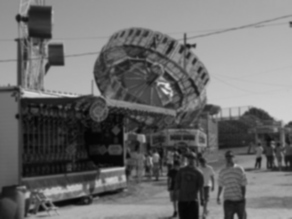
“Water Gun Fun, Aces High,” by Benny Mazur. Image has been blurred and converted to black and white color. Image was downloaded from Wikimedia Commons.
Though it is difficult to locate the exact origins of agricultural fairs in the history of the United States, it is reasonably safe to assume that fairs have existed in various parts of the country since at least the 1700s, when settler colonists undoubtedly such British and European agricultural traditions with them. Today, counties across the U.S. organize county fairs during the summer months. For millions of Americas, fairs have come to signify family-friendly community entertainment, complete with an assortment of fried and comfort foods, carnival rides, tractor pulls, 4-H and agricultural demonstrations, and other symbols (real and mythical) of rural life. Indeed, sport and the active body is often a key component of fair entertainment, arriving in the form of rodeos, racing competitions involving farming equipment and lawnmowers, guns, even the presence of military booths testing participants on their physical strength. County fairs offer a unique look at not only the workings and values within American culture, but the role of sport within those contexts.
County fairs in the United States, however, are also entertainment spaces rife with political meaning and shaped by the racial divisions of the nation. Scholar Benjamin Tausig considers county fairs a “fantasy of whiteness”: not only are they spaces typically predominated by white Americans, they are spaces of “political imagination” with “severe racial overtones” powered through symbols (like the Confederate Flag) and a accompanying and surrounding silence that emboldens their meaning. The fairs present a mythical vision of rural America that is not only a kind of pastoral utopia, it is a racialized fantasy that is perpetuated by myths of the nation’s rural past. Sporting practices are not disconnected from all of these things, and are often intimately involved in the reproduction of the fantasy at fairs.
This episode, posted on the eve of county fair season for this summer of 2019, takes a critical look at county fairs through the lens of race, Whiteness, sound, and sport/leisure. We interview Dr. Benjamin Tausig about his ethnographic research on county fairs, and his arguments that county fairs constitute a “fantasy of Whiteness” powered by symbols and silence. It our hope that the episode can provide listeners with a critical look at the historical, political, and racial dimensions of county fairs in American culture, and the ways sport, physical culture, leisure, and the active body are often implicated in those dimensions.
The impetus for this episode was Dr. Tausig’s 2018 article, “At the County Fair, A Fantasy of Whiteness,” published by arts and politics magazine Guernica. There are several websites that offer a brief history of agricultural fairs in the United States. One of the better brief histories is provided by Arcadia Publishing. To date, there remains a dearth of critical analysis on the question of race and county fairs, which makes Dr. Tausig’s research all the more fascinating and illuminating.
Dr. Benjamin Tausig is Assistant Professor of Ethnomusicology in the Department of Music at Stony Brook University. His research focuses on the intersections of sound, music, and political protest, with a particular focus on urban spaces. He is the author of Bangkok is Ringing: Sound, Protest, and Constraint, recently published by Oxford University Press.
Sound Acknowledgements: Multiples sound clips heard on this episode were taken from Freesound.org. These are sound clips of various county fairs across the United States. The sound clips can be found here, here, here, here, here and here. All music on the episode was written and recorded by Somatic co-founder Sam Clevenger.
Photo attribution: “Water Gun Fun, Aces High,” by Benny Mazur. Image was blurred and converted to black and white colors. Image was downloaded from Wikimedia Commons.

You must be logged in to post a comment.